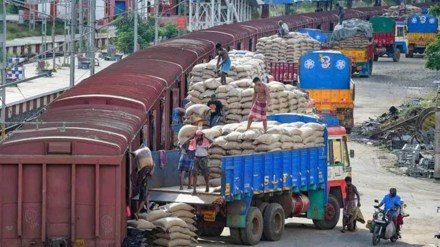By Viral Joshi and Shri Prakash
One of important measures for reduction of carbon emission in the country as envisaged in Nationally Determined Commitments is achieving railway’s share to 45 per cent in national freight transport by 2030, which is currently around 27 per cent. Longer turnaround time, multiple handling of goods, lack of seamless end mile connectivity, and inefficient goods handling are some of the reasons for declining share of railways.
The Mission 3000MT by 2027, launched in 2022 gave momentum to the Indian Railway (IR)’s efforts towards increasing freight loading. The Mission document has listed the infrastructure upgradation works, majorly focused on the line capacity upgradation, to be undertaken in coming years to realize the given target. In addition to that, robust and well-maintained freight terminals and their seamless and efficient operations will play a key role in helping the modal shift from road to rail.
IR has been an early adopter of technologies, starting from implementing computerized systems for freight accounting in 1967 and developing passenger reservation system in 1986 much earlier than other commercial and business entities have initiated computerisation. Railways established Centre for Railway Information Systems (CRIS) in 1986, which is responsible for design, development, maintenance, and implementation of different digital systems relating to railway operation, asset and personnel management. Unlike other business and financial sectors, computerisation in railways was an in-house effort and consequently much cheaper than others.
The current freight operation information system equipped with latest technology provides real time information regarding freight trains and helps in planning their movement. While IR is currently using internet-based systems; Rake Management System (RMS) and Terminal Management System (TMS), integrating terminal operations and performance additionally in the same system may enhance the efficiency and productivity of terminals.
Encompassing the concept of Internet of Things (IoT) to railway freight terminals can revolutionize logistics operations and maximize their capacity. Integrated Terminal Performance System (ITPS), developed at zonal/divisional level, can work as a centralized platform to consolidate data from various sources within the freight terminals, and allow authorities and users to have a holistic view of terminal operations. Enhanced visibility will enable proactive decision-making, quick identification of issues, and prompt action to mitigate disruptions.
Monitoring terminal detention time and wharfage time regularly, may help to identify any on-going or onset of any issue disrupting the terminal operations. A particular activity taking longer time can be identified, and further actions can be devised. For an example, if the wharfage time is higher, loading/unloading activities and freight vehicle movement can be looked into. Such monitoring systems may also be useful in validating wharfage and demurrage charges, and integrated e-payment systems can plug the revenue leakage effectively.
IoT systems can be a great tool to identify the daily and seasonal variations in the terminal operations. For many terminals, average wharfage time depends on the time of rake placement. If the rake is placed during evening hours or peak hours, the loading/unloading activities will be delayed due to unavailability of labour or congestion at access road respectively. Many terminals face longer detentions on account of seasonal problems like monsoon, peak summer etc. causing operational constrains. Real time data collections and analytics may help officials to identify such patterns at terminals, and proactive decisions can be made to optimize the operation.
Due to continuous movement of heavy-duty vehicles, the wharf, circulation area, and access roads of freight terminals are frequently worn out. ITPSs can be used to maintain detailed inventory of maintenance works, and advance intimation system may be developed to ensure the timely resurfacing and maintenance works. Such system can also be useful for preparing budgets to encompass all upcoming expenditures, as well as to ensure responsible utilisation of budgeted amount for maintenance/upgradation works.
ITPSs may help to facilitate seamless coordination among different stakeholders including terminal operators, freight forwarders, customs authorities and transporters. By integrating data and communication channels, ITPSs enable real-time information sharing, leading to smoother logistics operations, reduced paperwork, and improved coordination. IoT can be particularly useful for optimizing operations at inland container depots and parcel hubs, where multiple units and stakeholders are involved.
A detailed customer/operator feedback system for terminals can be devised and linked to ITPSs. Regular analysis of feedbacks can help understand the on-ground constraints and informed decisions can be made to optimize the operations. The real-time terminal information like, infrastructure condition, average loading/unloading time, availability of allied services, future availability for loading/unloading slot, and customer ratings may be made available to the customer while rake indenting to help them make suitable choices.
By integrating surveillance cameras and access control systems, ITPSs can also provide a comprehensive security framework. Any unauthorized access, suspicious activities, or safety breaches can be immediately detected and responded to, minimizing risks to personnel, cargo, and infrastructure.
Integrating ITPSs for railway freight terminals can bring numerous benefits, including optimal resource utilization, improved operational visibility, streamlined operations, data-driven decision-making, enhanced safety and security, and scalability for future growth. By harnessing the power of IoT, these terminals can reach maximum capacity, improve efficiency, deliver enhanced customer service, and ultimately achieve the desired targets of modal shift and freight loading.
The authors Viral Joshi is Research Associate in TERI and Shri Prakash, Distinguished Fellow, TERI and former Member (Traffic) at Railway Board
Disclaimer: Views expressed are personal and do not reflect the official position or policy of Financial Express Online. Reproducing this content without permission is prohibited.
